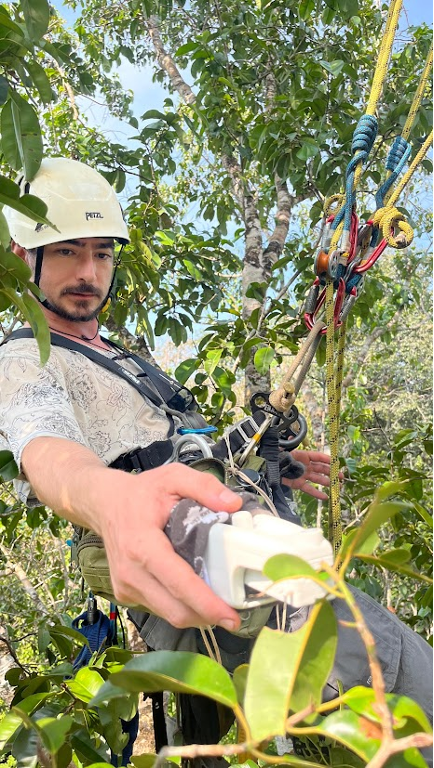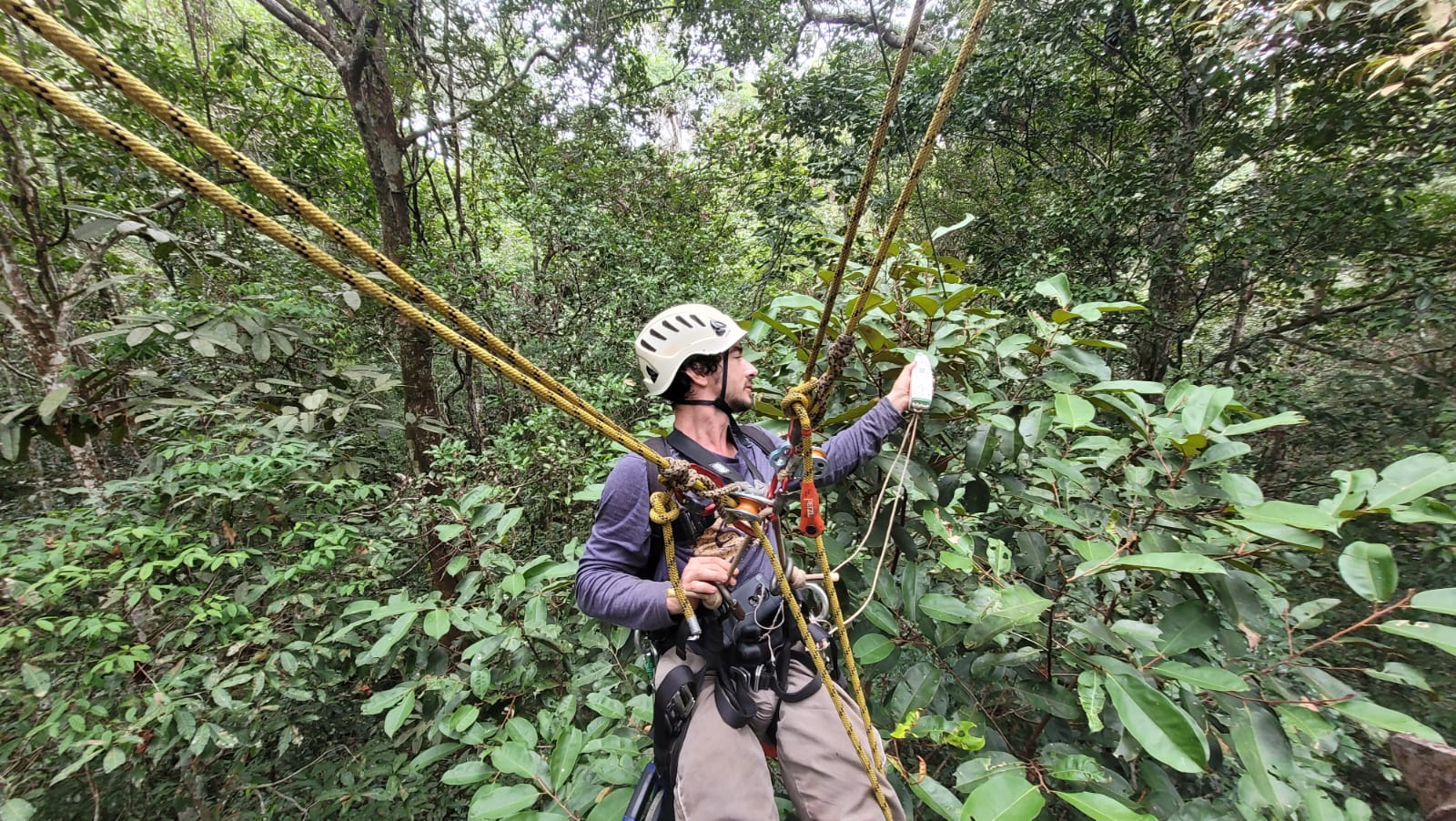Amazon trees under pressure: new study reveals how forest giants handle light and heat
In a first-of-its-kind study, researchers at Michigan State University have uncovered how Amazon rainforest canopy trees manage the intense sunlight they absorb.

In a new study published in New Phytologist, researchers at Michigan State University (MSU) have uncovered how Amazon rainforest canopy trees manage the intense sunlight they absorb—revealing resilience to hot and dry conditions in the forest canopy while also offering a way to greatly improve the monitoring of canopy health under increasing extreme conditions.
The study, led by doctoral candidate Leonardo Ziccardi with professor Scott C Stark in the MSU Department of Forestry, shows how tropical trees act like giant solar antennas—absorbing vast quantities of light energy that must be carefully managed. When trees absorb more energy than they can use for photosynthesis, it must be safely dissipated, either as heat or re-emitted as light—a process called chlorophyll fluorescence.

“It’s been a long journey,” said Ziccardi. “Since 2019, we’ve run multiple field campaigns across seasons, climbing giant trees in the heart of the Amazon to understand how these forests respond to environmental changes. We’ve spent hundreds of hours up in the canopy doing measurements—some of the most intense and rewarding work I’ve ever done.”
Ziccardi spent more than four years climbing trees nearly 200 feet tall in the central Amazon, measuring the fates of absorbed photons in thousands of leaves across many species, canopy heights, and light exposure conditions, producing a truly unique and unprecedented dataset.

Using a revolutionary handheld instrument—the MultispeQ, developed at MSU by co-author David Kramer in the MSU-DOE Plant Research Laboratory—Ziccardi captured how leaves in natural settings balance incoming light with their ability to photosynthesize or dissipate excess energy.
The findings offer a first-of-its-kind, high-resolution look at how the Amazon canopy navigates seasonal extremes. As the Amazon experiences increasing stress due to both greenhouse gases and deforestation leading to hotter and drier conditions in the canopy, understanding how trees manage light energy is essential to predicting their future survival. Not only does this climate change lead to greater physiological stress due to more frequent extreme conditions related to lower soil water availability and dry and hot air, it also can increase the amount of sunlight hitting the forest. This happens because drier conditions have less clouds and that lets more sunlight through. This study helps address whether Amazon trees can absorb and use this extra light under stressful conditions.
Despite facing intense sunlight and atmospheric dryness, many canopy leaves were able to continue photosynthesizing, but only by increasing their allocation to energy dissipation pathways. For the first time in the Amazon, the study revealed a nuanced, three-phase response of leaves to rising light and drought conditions—under low to moderate light, leaves balance energy use between photosynthesis and fluorescence, so these processes tend to increase and decrease together. As light and drought stress increase, however, this balance breaks down. Heat-protective dissipation mechanisms become overwhelmed, photosynthesis drops, and fluorescence can spike—signaling potential damage to the photosynthetic machinery.

The implications are critical for scientists using satellite observations of fluorescence—the so-called solar-induced fluorescence (SIF)—to monitor Amazon forest health. While SIF is often used as a proxy for photosynthesis, this study shows that photosynthesis and fluorescence do not always go up and down together. Under high light and stress, this relationship breaks down and leaves may fluoresce more even as their photosynthetic machinery declines, potentially leading to overestimates of ecosystem productivity during droughts.
By mapping how fluorescence and photosynthesis vary across canopy strata, seasons, and species, the research provides new insight into the emergent SIF signal measured from space. This knowledge will improve models linking SIF to carbon uptake, helping researchers better monitor when and where Amazon forests become vulnerable to climate extremes.
Another very unique aspect of this study is that it measured how solar energy flows through leaves across a wide range of canopy heights and exposure conditions—something that had never been done at this scale in the Amazon before. Tropical forest canopies differ across regions and environments in how open vs closed, in how tall vs short the biggest trees are, and in other structural aspects that are increasingly being linked to forest health and climate cooling function. Also this structure can change because of stress if, for example, more trees die from droughts opening up more heterogeneous conditions in the canopy. This type of understanding is important for the most current generation of global vegetation models that look at how forests impact the atmosphere.
This research also had to adapt to surmount the challenges of the COVID-19 pandemic, which limited travel and work in the field for an extended time in its early phase. In this environment, the simple-to-use hand held solution offered by the MultispeQ became an even more advantageous tool for investigating canopy photon absorption and photosynthesis, allowing a small nimble team to safely and rapidly begin to collect data as soon as field sites re-opened. Ultimately, the researchers invested in sampling more environments, trees, seasons and forests with the MultispeQ than initial plans. Today the result of this is that the broad swath of data collected over the natural variety in the tropical rainforest canopy is one of the study's most unique assets.

The Amazon plays a vital role in global climate regulation, recycling moisture into rainfall and storing vast amounts of carbon. But this system is under threat. Deforestation and rising greenhouse gases are destabilizing rainfall patterns, and the Amazon River hit its lowest recorded levels in 2023 and 2024. Unlike drier northern forests, however, the Amazon has not yet seen widespread tree mortality—raising urgent questions about how long this resilience can last. Canopy function studies like this one are an integral component of addressing how resilient the Amazon can be.
"To understand the Amazon’s tipping points, we have to start in the canopy," said Stark. "This is where trees experience the effects of heat and drought as an impact on their most basic function of photosynthesizing food—determining whether forests can keep functioning or begin to fail. In other parts of the world like some drier parts of the US, the resilience of forests has already been overwhelmed by climate change leading to absolutely catastrophic tree die offs, changing complete landscapes and harming the fight against climate changes since trees are so crucial for storing carbon from the atmosphere and transpiring water which directly cools the air and produces rainfall and clouds”.
The study sheds light—literally—on one of the most urgent ecological questions of our time: How are Amazon trees surviving climate extremes, and for how much longer can they endure?
Leonardo Ziccardi was funded by the prestigious Future Investigators in NASA Earth and Space Science and Technology (FINESST) award (nº 80NSSC24K0020) from the Early Career Research Program in NASA's Earth Science Division. The study was also supported by the National Science Foundation Division of Environmental Biology (NSF DEB) awards (grant numbers 1950080 and 1754357.)
About New Phytologist
New Phytologist is a leading international journal focusing on high quality, original research across the broad spectrum of plant sciences, from intracellular processes through to global environmental change. The journal is owned by the New Phytologist Foundation, a not-for-profit organization dedicated to the promotion of plant science.
Rivers Above the Canopy
Ziccardi’s work has also been featured in the documentary “Rivers Above the Canopy,” by
Pascal Cuissot. “The epic journey of science explains how mighty forests bring their own freshwater from oceans (Biotic Pump) through colossal aerial flows of moist air (flying rivers).” Production: ZED & Grifa Filmes (Brazil) for ARTE France & NHK



 Print
Print Email
Email




